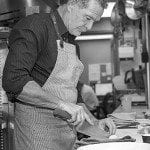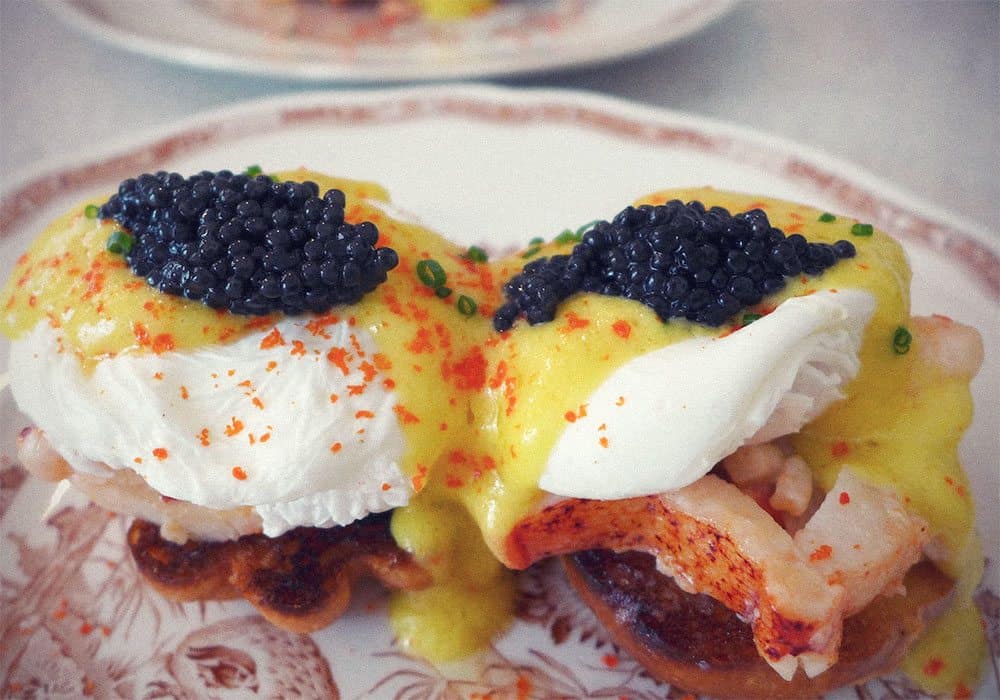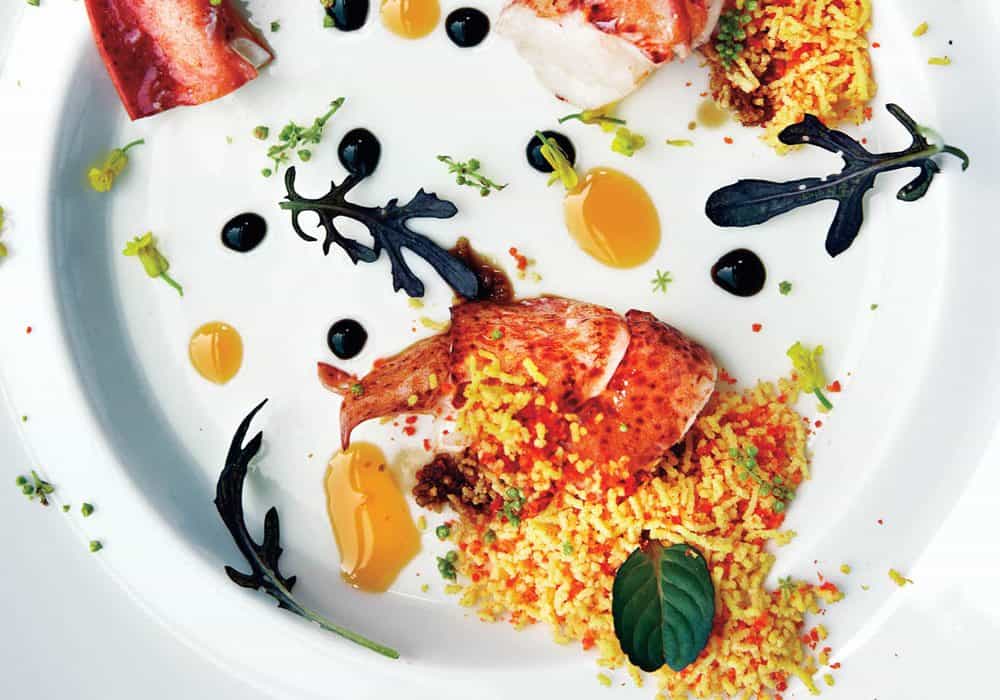
By Chef-Owner of the McEwan Group, Mark McEwan
I put this on the menu at North 44, in the ’90s.
It was the first squab dish I ever made—and to me it’s still the best squab we’ve ever done. The squab breast is roasted on the crown, a perfect medium-rare. Then you have the voluptuousness of the confit. You’ve got a Brussels sprout slaw, wilted and green—with just a little bacon. A tablespoons of braised lentils, on the liquid side. Then there’s the richness of the cauliflower purée, and for contrast, the bright, sweetness of the apple. The flavours are like a walk through the fall. The components are basic—and having to cook it all shouldn’t frighten anybody. It all comes down to execution. Which I like and value, especially nowadays, when everything seems to be cooked sous-vide by computer control instead of passion.
– Mark McEwan
Squab:
- 4 fresh squab, about 600 g (1¼ lb) each
- 60 mL (¼ cup) olive oil
- Salt
- 2 disks lemon, about 5 mm (¼-inch), charred on grill or dry skillet, halved
- 4 cloves garlic, smashed
- 8 sage leaves
Rub:
- ½ tsp each black peppercorns, coriander and cumin seed, plus ¼ tsp each dried rosemary, ground nutmeg, cinnamon and clove (toasted and ground)
- 750 mL (3 cups) rendered duck fat
- 250 mL (1 cup) veal jus (optional)
- 1 tbsp whipped butter (optional)
Cauliflower:
- 300g (10 oz) cauliflower, sliced thin
- 600 mL (2½ cups) milk
- Pinch of salt, ground white pepper
- Tiny pinch of nutmeg
Lentils:
- 1 tbsp olive oil
- 50 mL (¼ cup) minced onion
- 1 clove garlic, minced
- 125 mL (½ cup) beluga lentils, picked
- 50 mL (¼ cup) white wine
- 500 mL (2 cups) chicken stock
- ½ tbsp butter
- Salt and pepper
Apples:
- 1 large cooking apple, peeled
- 1 tbsp granulated sugar
- 1 tbsp olive oil
- 1 tbsp butter
- 250 mL (1 cup) dry Riesling
- 1 pinch cayenne
Sprouts:
- 8 to 10 Brussels sprouts
- 1 tbsp olive oil
- 1 thick rasher of bacon, diced
- 1 tbsp butter
- Salt and pepper
Makes:
4 Servings
The day before cooking the squab, cut off the birds’ heads at the base of the neck, remove the top two joints of their wings along with the feet and reserve for stock. Trim off any extra skin or fat and discard. Pat the birds dry with paper towels, place them breast side up on a roasting rack, and allow to dry overnight uncovered in the refrigerator.
Preheat oven to 95°C (200°F).
Separate legs of each bird from main carcass at the base of thigh, cutting very carefully so as not to remove too much skin from the breast. Rub a few drops of olive oil on each bird. Insert a pinch of salt, the lemon, sage and garlic into each cavity. Tie a string snugly around the bird lengthwise in a loop running under the neck, over the wings and around the cavity opening. Salt the exterior, pressing the crystals into the flesh. Season each bird generously with the squab rub. Repeat for the legs, on both sides.
Now, heat the duck fat in a small saucepan on low heat to no higher than 95°C (200°F). Heat a large nonstick skillet on medium. Add remaining olive oil, and sear the birds on all sides until brown—about 10 minutes. Also sear the legs, but only on the fatty skin side. Set the birds aside on their roasting rack. Add the legs to the duck fat and transfer the pan to the oven for 30 minutes, by which time the meat should be beginning to pull away from the bone. Transfer the legs to another dish and set aside.
Preheat oven to 220°C (425°F).
Combine cauliflower, milk and seasonings in a saucepan and bring to a simmer over low-medium heat, stirring frequently to ensure that the milk does not burn. Simmer, stirring regularly, for approximately one hour—or until cauliflower falls apart when pierced with a fork. Strain, reserving the milk, and transfer the cauliflower to a blender. Add enough reserved milk to make a purée. Taste, correct seasonings, and adjust consistency with more of the reserved milk if necessary. Pass through a fine mesh sieve and reserve.
For the lentils, place a medium saucepan over low-medium heat, add the oil and then the onion. Salt lightly and sweat for five to seven minutes, until translucent, and then add the garlic. A minute later add the lentils, stir well and deglaze with the wine. Add 1 cup chicken stock and bring to a simmer. Stir regularly, adding more stock ¼ cup at a time as the mixtures thickens. When the lentils are tender— about 30 to 45 minutes—remove from heat, stir in butter, and season.
Use a half-inch melon baller to scoop perfect balls from the apple. In a mixing bowl, toss apple balls with the sugar to coat. Sautée in oil and butter until uniformly bronzed. Then add wine and cook until it reduces to syrup and the apples are just tender. Add a pinch of cayenne and stir. Set aside.
Peel the outside five or six leaves from each Brussels sprout. Then shred the remaining spout crosswise on a mandolin. (You want end up with roughly twice as much slaw as whole leaves in the mix.) Bring a large pot of salted water to the boil, blanch sprouts for 30 seconds, chill in iced water, and drain. In a skillet or small sauté pan, heat the oil on low and render the bacon until it starts to crisp and turn golden. Add the sprouts, toss, add butter, season and reserve.
Position squab on roasting rack at the middle of the oven with wing joints near the back wall. Roast for 10 to 12 minutes. Remove and let rest for five. Meanwhile, transfer squab legs to to the top shelf of the oven to crisp. Two minutes later, return the squab to the oven to crisp—for two minutes only. Meanwhile, gently reheat the cauliflower, lentils, apples and sprouts. Optional: heat the veal jus on medium. Remove squab from the oven and carefully fillet the breast halves from each crown. If using veal jus, remove from heat and whisk in butter. For each plate, smear cauliflower purée down left side of plate. Mound slaw at top, and lentils just below. Prop one breast half against the slaw, follow with another and then the two legs. Finish with a few apple balls and—if you choose—a drizzle of veal jus.




